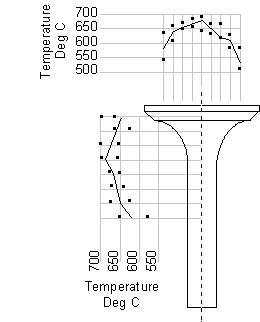
G&S Valves Ltd
Manufacturing Bespoke Engine Valves Since 1946
Technical Information
Valve Steels - Various steels are available, these include the following:
EN52
For many years the standard exhaust valve steel was EN52, this steel was first introduced over 70 - 75 years ago. But since then improved engine design including increased compression and higher operating temperatures, and improved fuels with an increased octane rating and addition of tetra-ethyl-lead have lead to an increasing tendency to prematurely burnout the valve. This steel is classed as "semi" corrosion resistant as they are attacked by Chlorine and Sulphur compounds. As a result this material is no longer considered suitable for exhaust valves, although it is still perfectly satisfactory for inlet valves.
EN54, KE965 & Jessops G2 (No longer available)
Developed to replace EN52 as an exhaust grade steel, this steel possesses excellent creep strength and impact values at high temperature, and has good scaling and corrosion resistance, except in the presence of sulphur, and its resistance to oxidation extends to temperatures above 900 Deg. C. EN54A was expensive to manufacture (in its time) due to the high Nickel content so a new material was developed which was EN59.
EN59 (No longer available)
This material had a lower thermal expansion rate and good heat conductivity properties which gives much better resistance to high temperature scaling. This steel is resistant to Chlorine compounds but not Sulphur. It is suitable for use where resistance to high octane rated fuels and oils containing tetra-ethyl-lead.
214N (349S52)
About 1960 a new steel, 214N was developed. This steel retains its hardness even up to temperatures of 800 Deg. C and possesses excellent rupture strength under high temperature conditions combined with good creep and impact values, The high Chromium content gives good scaling resistance, and has greater corrosion resistance against Chlorine although is still not immune to sulphurous attack.
1.4882
This material has the same properties as 214N (349S52) but with addition of Ta (Tantalum), Nb (Niobium) and W (Tungsten). This gives it greater elongational properties, improved tensile, yield and creep strength.
Note: This material is available in stem sizes of (7.44mm - 9/32") or less.
Nimonic 80A
Nimonic 80A has an increased operating temperature over 214N and higher corrosion resistance.
Typical Exhaust Valve Operating Temperature
Heat flow is through the Back-of-Head (piston side) by radiation during combustion and by conduction through the Back-of-Head, Seat and Stem during the exhaust stroke. Valves pass 75 % of their heat through the valve seat to the seat insert and 25 % from the valve stem to the valve guide.

© Copyright G&S Valves 2014
Website Design by heatherdesign.co.uk